

Interestingly enough most of the towns/estates of Sypniewo fall into the 52-53 degree Latitudes and range from 16-22 degrees East Longitude, and all the estates called "Sypniewo" were in Wielkopolska. This branch of the Sypniewski family is of the Roman Catholic faith. Their holdings take in 2,425 Morgs. A Morgan is 2/3 of an acre in Prussia.
On my grandfather's citizenship papers it states that he was from the L~omzynska diocese. A church that was built right after Kazimierz Sypniewski left Poland to emigrate to the United States of America still is in this region. It is the Parish of St. John the Baptist, which was founded on July 22, 1914, two years of my father's birth here in the U.S.A. The church address is:
Sypniewo This parish includes Sypniewo, Batagowo, Chelchy, Dylewo, Clays Rafaly, Glowed, Majki, Mamino, Presniska, Old Clays, Strzemierczne, Sypniewo New, and Ziemaki.
Street Ostrolecka 24
06-216 Sypniewo
gm. Sypniewo, pow. makowski, province Mazovian.
| Name of Town | Latitutude | Longitude | Altitude in feet | Altitude in meters | District | Postal Code |
| Sypniewsko | 53 N | 16E | 419 | 128 | W. of Sypniewo, E. of Nadararzyca | ... |
| Sypniewo #1 | 52N | 17E | 259 | 79 | Wielkopolska: Poznan(south of Margonin) | 64-830 |
| Sypniewo #2 | 53N | 21E | 318 | 97 | Wielkopolka Siedziba Gminy | 06-216 |
| Sypniewo #3 | 53N | 17E | 446 | 136 | Wielkopolska: Kijawski-Pomerse | 89-422 |
| Sypniewo #4 | 53N | 16E | 439 | 134 | Wielkopolska: Zlotow | 64-962 |
This information is from Falling Rain Genomics, Inc. at Poland - Sy
The Zlotow Sypniewo #4 in Wielkopolska
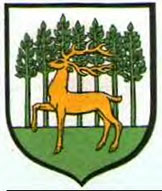
In the Slownik Geografyczny there are listed three estates or towns named Sypniewo (#4 on my chart). The village Sypniewo was inhabited since 1380. However in 1260 the land was owned by a man called Jan. The word "sypien" referred to a great wooden funnel through which loose grain flowed to the storage silo or barn. Often this grain was in payment for the land that they planted. Around 1380, the name of the village was first known as Synewo. In 1426 it was called Syniewo; in 1435 it was spelled Cypniewo/Szpniewo, and then Sypniewo I and finally it was just Sypniewo. Sypniewo was first was established in 1435 as a village, and was originally known as Czypniewno, a village with its own church in the district of Zlotow, on the highway to Zlotowaki-Wiecborska (no longer on the map). Located 20 miles east of Zlotow, it is composed of sandy dunes and sandy soil, and is approximately 585 hectares (=1,443.535 acres) in area. There are 540 hectares (=1,334.34 acres) of fields, 15 hectares (=37.065 acres) were lakes and 16 hectares (=39.536 acres) of forests (circa 1885). On this property there were sixty homes, and eighty-eight huts. The population (in 1885) was approximately 427 composed of 350 Catholics and 67 Protestants/Lutheran Evangelists, and 10 Jews. There was also a post office, and a 4-room school. In 1778, there were three teachers and 271 students in attendence.
This is the coat of arms described as Jakob/Jacob Sypniewski's wife's clan in Golden Book of Polish Nobility. CLICK HERE for more on this family tree.
Notice how the description of this clan's coat of arms, resembles the Zlotow coat of arms.
The following is a direct translation (by Leonard Suligowski, Heraldry Director of the Polish Nobility Association Foundation)) from the classical genealogical and heraldic reference "Herbarz Polski" by Kasper Niesiecki, S. J., Lipsk edition, 1839-1846.
According to Okolski's description there is a red stag on a white field with forelegs raised as if for swift chase after driven animals; a crown is on its neck, and on the helm are peacock feathers. But in a book on Polish emblems I read that it should be a white stag in a red field. Lublin province uses such arms; but Petrasancta cap. 54 is a witness that in Britain, France, Italy, and Germany there flourish a great many houses who sport a stag in their arms. No one gives these arms an occasion; only Okolski adds that they were brought to Poland from Germany. I have not read what families use the arms in their seals, only of the Sobeks of Sulejów, of whom I will speak in the proper place.
Perhaps this is not coincidence. Perhaps these families were very notable in the early history of this area?
The Runge-Sypniewski Property in the Zloczowski District
The property called Sypniewo was owned by knights, as stated in early chronicles. In the 15th century they were named Runge and Dzwierszna. One of their family inherited one part and the second part was owned by his son. Since the year 1498 the owner of Sypniewo was Nicholas Sypniewski of the Odrawaz coat of arms. From 1540 it was owned by Jacob Sypniewski who had a grandson named Jan. Sypniewo was composed of the colony of Adamkowo, which in 1885 had 28 dwellings and a population of 151. The farm of Adamkowo had 2 dwellings and a population of 58 people. The colony of Charlottenhof had 2 dwellings and a population of 57. Included in this property were also the forests of Dortheenhof, and the farms of Dorotheenhof, which included 3 dwellings and a population of 58 people. Others were Hammermuehle, Ludwigshof, Lukowo (3 dwellings, 57 people), Werskerbrueck, Wymyslowo, Wolfschlucht and a brick factory, making a total of 71 dwellings, 168 Dym(?), 961 people (557 Catholics, 404 Protestants), 3,613 hectares (= 8,027.723 acres) (measure of land), of which 1,585 were being cultivated, 290 were pastures, and 1,395 were forests. There was a distillery, a brick factory, a saw mill, two grain mills, an oil production factory (for rendering fat), a factory for milling bones, and a cattle breeding farm. The soil here is fertile and the population lived off agriculture and the raising of cattle.
On the farm of Dorotheenhof, in 1880, there was found some smaller metal items serving to adorn, and fragments of metal tools (see Pielgrzym, 1880. #4).
From the fourteenth (14th) century to the fifteenth (15th) century (as mentioned above), Sypniewo was acquired by the Runge-Sypniewski family. Sir Jacob Sypniewski owned this property, and the properties of Dzwierzno (in the district of Zloczowski) and Jutrogosc. Jacob's ancestors were from West Prussia. The branch other of this part of the family took the name of Dzwiergowski, named after Dzwierzno, which was owned by Marcin Sypniewski. The Galicia/Austrian family is a branch of the Jesewskis. They proved their nobility in 1825.
Later owners of this property were: the Witoslawski (of the coat of arms Prawdric), the Bialosliwsey of the coat of arms "the Axe," the Dzialynski family (of the coat of arms Ogonczyk) In 1749, Ludovica Dzialynski owned Sypniewo, and the Gotzendorff-Grabowski family (of the coat of arms Zbicswicz). The Grabowski owned Sypniewo from 1711-1834). In 1722, Andrzej Teodor Grabowski was the district judge in Czluchow. In this year, he transferred his property to his eldest son, Adam, who was scribe in the court of Pomorze. Adam was given Buczek, Wielke (acquired in 1571 on the feast day of St. Bartholomew, the Apostle) and Male (acquired at the same time as Wielke), and Czyszkowo for 42,000 Prussian zloty (=5/6 to 1 zloty). In 1766 Sypniewo had 385 citizens of which 367 were Catholic. Andrzej Teodor Grabowski's son Adam also inherited Breitenfielde, Platendyk, Jaczonki, and Mekowy. To his second son Andrzej Teodor Grabowski gave: Debrzno, Kape, Blugowo, and Huetten for 75,000 zloty. To his third son: Sypniewo, Llowo, Radonsk, Jadrowo, and Lukowo for 75,000 zloty. To his younger son: Grabowo, Zamarte, and part of Blumfield, Nowydwor in Czluchowski province, Ogarzeliny and Ciecholewy. To his friend, Kazmierz Wolszlegr, he bequeathed a quota of 5,000 zloty. Jutrogosc and Izdebke were given as an allowance to his youngest daughter. The Grabowskis owned Sypniewo from the times when it was part of Poland. Later it was acquired by the main bank in Berlin (Der Kreis Flatow von Schmitt, pg. 192) on January 4, 1824. This as a result of the 1793 Treaty of Partition. The Berlin bank took the fortune from Joseph Grabowski in October 1830. It was sold to Herman Wilckensowi and Frances Frydrychowi Nagela. On January 1, 1849, Frances Frydrychowi Nagela sold the property to Dorothea Justin Wilckens of Willich. She was the wife of a financial councillor. Their son Lebrecht Gottvertrau Wilckensowi inherited Sypniewo. A road was built from Zlotw to Sypniewo on October 14, 1853. By 1896, Sypniewo was part of a railway system (from Zlotwo to Sypniewo to Wiecbork). Sypniewo also had their first District Bank.
In 1939 the German Army occupied Sypniewo. Sypniewo was located near the Lonzonki River which was about 6 kilometers away. The town was evacuated after word of the German invasion. Camps were formed in Radzimiu and Karolewie for captured Poles. Sypniewo then was owed by a member of the Germand SS. During the German occupation of Sypniewo, there was a German school established and Poles were no longer allowed to speak their native language. Children who tried to speak in Polish were beaten.
By 1945 there were battles on the Vistula and Order Rivers, when Soviet armies entered Sypniewo. The first battle lasted for about four hours. It was now the Soviets versus the Germans. The Germans were the victors.
On January 29, 1945, Sypniewo was liberated from German occupation. From this date on, Polish members of the village returned to their homes. They then had 38 new farms. The rest was made into State forests. In 1945 the Wilckensow family left Sypniewo, and their manor house was made into an Agricultural school. In post war times, Sypniewo had a distillery, creamery, bakery, two blacksmith shops, two shoemaker's shops asnd three grocery stores. In 1951, Sypniewo finally had electricity. Before this only select homes had electricity. The Sypniewo library was the former home of Frances Tarapackiego. In 1968, Sypniewo had its first veterinary clinic.
The Poznan Property - Sypniewo #1
Brochwicz:
(Palatinate=Rawa ... District=Sochaczew),
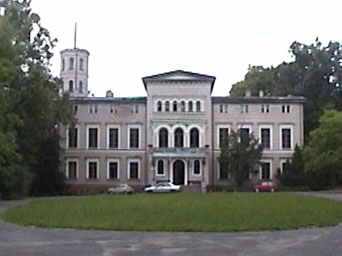
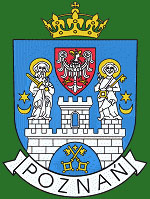 Poznan Coat of Arms
Poznan Coat of Arms
The third village called Sypniewo (#1 on my chart) was in the Poznan Province. This Sypniewo was located on the west bank of Margonin Lake. It was first recorded in 1380 in various writings. They had a farm near Wagrowiec, four to eight kilometers south of Margonin; north-west from Kumik, near the border of Sredzki Province; between Kamionski, Piotrow, and Szczytnike. There was the Parish of Gluszyna, a post office, and a railroad station of Gadek. Gadkach (Gondek) was about 3 1/2 kilometers and had four dwellings, and 28 Catholics living there. Of the land, there was 57 hectares (= 140.847 acres) (40 cultivated, 5 pastures, 1 forested). Around 1840, Sypniewo belonged to the Sypniewskis from Piotrow.
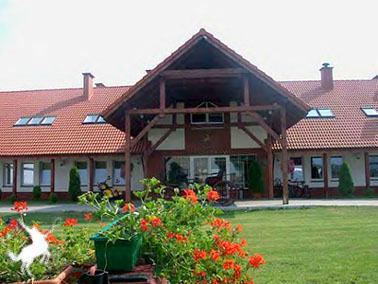
The Germans immigrated to Sypniewo around 1740 or before. Around 1800, this property was part of a large estate called Sypniewo (Secort, Kreis Kolmar in German), which had 500 hectares (= 1,235.5 acres), 52 hectares (= 128.492 acres) of meadows and 84 hectares (= 207.564 acres) of forests. As early as 1380 this estate was well-known to the locals, since it belonged to Jan, the Mayor of Kwieciszewo. Around 1793 the land was owned by Fryderyk Skorzewski (an Odrowaz?). It is not known how the 40 hectares (=98.84 acres) of land, with manor house, was disconnected from the rest of the estate. But, from 1800-1836, the estate was owned by Jozef and Justyna Sypniewski, who were said to have moved there from Piotrow. Josef and Justyna were the parents of:
Antoni Sypniewski, Josef's bachelor brother, also lived in the estate. Antoni was a captain in the Polish Army, and participated in the November Uprising. In the battle of Ostroleka, in 1831, he was seriously wounded in the leg. The family had thought that he was killed, since no word came as to his whereabouts. Eventually, he returned to Sypniewo with a very infected leg and sought medical attention. The Prussians saw his going home as desertion, even though they had no medical help to give him. The story goes that had he not left, he surely would have perished from blood poisoning. The Prussians turned on the entire Sypniewski family after this event, and confiscated their estate. Josef Sypniewski, feeling that this was an foul turn of fates, sued the Prussians for their unjust acts towards his wounded brother. After a few years of legal battles in the courts, Sypniewo was returned to the Sypniewski family. However, in the years leading up to the court judgement, Josef and Justyna had been forced to settled in Zborow, near Ksiaz. They died here in their mid-60's, during a cholera epidemic.
During the 2nd Swedish war, Sypniewo and Samotschin were destroyed, only Margonin was partially retored.
The Sypniewo estate then fell apart and their legacy was divided among surviving family members. The part of the estate which was Josef Sypniewski's share was said to have been worth 11,000 talars. This part went to his children, Edward Sypniewski (born March 28, 1848) and Justyna Sypniewska (born in 1850). Their legacy was held in trust, because they were still minors. They were then cared for by their uncle Josef Gutschem, husband of their father's sister, their aunt Justyna. Their father's will had asked that part of the trust fund be used for his children's education, while the rest was to be transfered upon their coming of age. Edward Sypniewski was sent to a grade school in Srem. However, the rest of the inheritence his uncle kept for himself. This action showed Josef Gutschem to be a treacherous and untrustworthy man.
After graduating from the fifth grade, Edward Sypniewski was bought back to the estate, by his uncle, and sent to work as an apprentice mechanic in Poznan. His uncle. again going against his brother-in-law's wishes that his issue be educated in an institution of higher learning. The young Edward Sypniewski could not thrive in this working environment, which was bad for the lungs, so he returned to his estate in poor health. His uncle, Josef Gutschen, cared not for his plight. Then Edward sought the help of the husband of his other aunt, Ferdynand Jackowski. His uncle Ferdynand, husband of Bronislawa Sypniewska, did what he could, and sent Edward to apprentice at a local distillery. This distillery was on the estate of Klenka, also in the district of Poznan (near present day Nowy Miasto). This was the Gellert Distillery. The owner of the estate was called Kenneman. He was the organizer of the anti-Polish Association known as Harata. So again Edward Sypniewski encountered ill fate.
After finishing his internship, Edward took his first job in the village of Slawsk, in the Konin district. He now was working on the estate of the Bietramow brothers. All three of these brothers were Russian generals. However, Edward managed to make the most of his lot in life. Edward worked here for many years, and then married and started a family. Edward Sypniewski married (1) Rozalia ? :
Upon the birth of Edward, Edward (Sr.) and Matylda Sypniewski had finally saved some money and were able to finally buy their own land at Slupca in Krzywda. On this parcel of land was built a wooden house. After owning this land for a few years, Josef Sypniewski sold it to the Gorzkowski family. The beams, used in the construction of this house, were said to have come from the forests in Kazimierski, and were not allowed to dry properly. Legend says that sap leaked from these beams for 60 years. An old family legend said that the timbers leaked because of the all the injustices done to the Sypniewski family. The house wept for its owners.
By 1939 there were approximately 75 Hectare, and in 1945, the estate was owned by the family Laasch.
The Children of Edward Sypniewski and Rozalia were:
The children of Edward and wife (2) Matyldya Sypniewski (nee Gutschem) were:
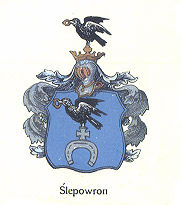
The Wyszogrod Property called Sipniewo(not to be confused with Sypniewo):
This property was near to a few of the Sypniewo properties. It is listed in Ignacy Kapica Milewski's Herbarz, published in Krakow, Poland in 1870 (page 369). This was submitted to me by Klaus Liwowsky (KlaLiwo@web.de) on September 7, 2001.
484. The House of Sipniewski (coat of arms Slepowron)
An ancient house with the same beginnings as Czartoszewski and Gawkowski.
1406, Wyszogrod. John [Janus I 1381-1429, a Piast] (Johannes), duke of Masovia (ksiaze Mazowiecki), in the presence of faithful and humble servants to us (to our service) designated and introduced by Nicolas [Sipniewski], the heir of Sipniewo, after giving to him in perpetuity 20 mansi (of Chelmno standards) of forest in an area called Czartoszewo, adjacent to a stream called Horz, bestowed on him (special) privilege.
This privilege No 131 is recorded under the: Gawkowski family (of Slepowron coat of arms) and pertains to the land (possessions) of Gawki, as proven by the records of the county court of Lomza.
1420, Lomza. John, senior duke of Masovia; we confirm, etc. that Vincent of Sipniewo, appearing personally before us, sold in perpetuity 10 mansi (measured by the Chelmoe standard) to our faithful: Niewstamp of Czernino, Mscislaw and Nicholas for 9 sexagons (Polish monetary unit of kopa=60). On this sale (transaction) the same Duke bestowed a privilege.
This privilege is recorded as No.77 above under the house of Czernino as well as will be recorded below as No. 626 under the house of Zarembow.
( This portion was translated from Polish and Latin, to English, by Rev. Bernard L. Pilarski).
I would like to learn more about this variation. At this time, this line seems to have no connection to the Sypniewski family.
John was a member of the Piast Dynasty, one branch of which ruled in Mazovia.
SEE LINK HERE
MORE ON S~LEPOWRON...CLICK HERE
RELATED LINKS:
Source:
Walewski, Wladyslaw. Slownik Geografyczny II "S". Warsaw: Krolestwa Polskiego-Pod Redakcya Nakladem, 1890.

© 1997 E-Mail:Vondoering@aol.com
